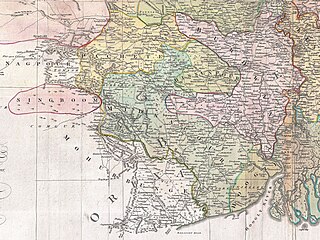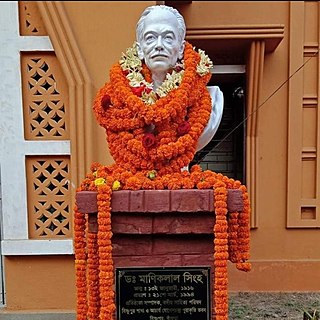
Bishnupur is a city and a municipality in Bankura district, West Bengal, India. It has terracotta temples built by the Malla rulers, historic Radha Krishna temples built during 1600–1800 CE and the Baluchari sarees. In 1997 the temples of Bishnupur were placed on the UNESCO World Heritage Site's Tentative list.

Mallabhum was the kingdom ruled by the Malla kings of Bishnupur, primarily in the present Bankura district in Indian state of West Bengal.
Hambir Malla Dev was the forty-ninth king of Mallabhum. He ruled from 1565 to 1620 AD.
Adi Malla, also known as Bagdi Raja, was the founder of the Mallabhum sometime in the 7th century CE.
Jay Malla, also known as Joy Malla & Jai Malla, was the son of Adi Malla, the founder of the Mallabhum.
Bir Malla, also known as Bira Malla was the forty-seventh king of the Mallabhum. He ruled from 1501 to 1554 CE.
Dhari Malla was the forty-eight king of the Mallabhum. He ruled from 1554 to 1565 CE.
Dhari Hambir Malla Dev, also known as Dhari Hambeera was the fiftieth king of the Mallabhum. He ruled from 1620 to 1626 CE.

Raghunath Malla Dev, also known as Raghunath Singha Dev, was the fifty-first king of the Mallabhum. He ruled from 1626 to 1656 CE.
Raghunath Singha Dev II was the fifty-fourth king of the Mallabhum. He ruled from 1702 to 1712.
Durjan Singha Dev was the fifty-third king of the Mallabhum. He ruled from 1682 to 1702.
Gopal Singha Dev I was the fifty-fifth Raja of Mallabhum. He ruled from 1712 to 1748.
Nilmoni Singha Dev was the sixtieth king of the Mallabhum. He ruled from 1889 to 1903.

Bir Singha Dev, also known as Beera Singha was the fifty-second king of the Mallabhum. He ruled from 1656 to 1682 CE.
Gopal Singha Dev II was the fifty-eighth king of the Mallabhum. He ruled from 1809 to 1876 CE.
Ramkrishna Singha Dev was the fifty-ninth king of the Mallabhum. He ruled from 1876 to 1885 CE.
Kharga Malla was the twelfth king of the Mallabhum. He ruled from 841 to 862 AD.
Chandra Malla was the forty-sixth king of the Mallabhum. He ruled from 1460 to 1501 CE.

Maniklal Sinha, also Maniklal Singha; was an Indian archaeologist, writer, poet, folk-culture scholar (Lokasangskritibid), novelist and assistant teacher at Bishnupur High School. He was the main entrepreneur and founding director of Acharya Jogesh Chandra Pura Kirti Bhavan(museum) and Bangiya Sahitya Parishad – Bishnupur Branch in 1951 at Bishnupur. He was awarded an honorary D.Litt. degree by the University of Burdwan in 1989 for his contribution as an archaeologist, writer and novelist.

Mrinmoyee Temple is an ancient temple in the town of Bishnupur in Bankura district of the Indian state of West Bengal. It was founded in the 10th century by the Malla king Jagat Malla.







